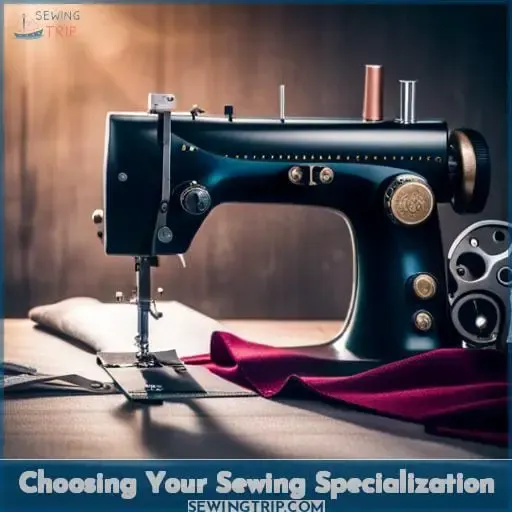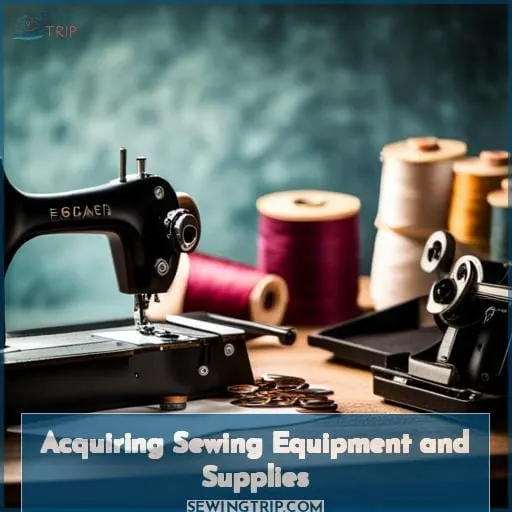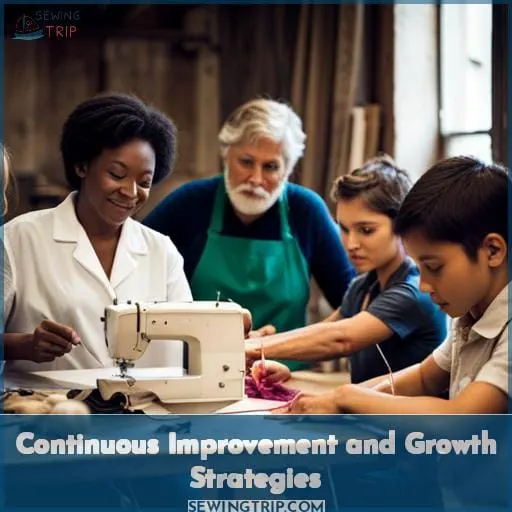This site is supported by our readers. We may earn a commission, at no cost to you, if you purchase through links.
 Discover how to start your own sewing school and share your passion for sewing with others.
Discover how to start your own sewing school and share your passion for sewing with others.
Market research will help you assess the demand and competition in your area, while choosing a specialization allows you to focus on specific techniques or skill levels.
Plan a structured curriculum, set up a suitable space for classes, and acquire necessary equipment and supplies.
Learn about hiring instructors (if applicable), marketing strategies, pricing options, managing finances, building community connections, and continuous improvement for growth.
Let’s get started!
Table Of Contents
- Key Takeaways
- Market Research for Your Sewing School
- Choosing Your Sewing Specialization
- Planning Your Curriculum and Lesson Structure
- Setting Up a Suitable Space for Your Sewing School
- Acquiring Sewing Equipment and Supplies
- Hiring and Training Instructors (if Applicable)
- Marketing and Promoting Your Sewing School
- Setting Pricing and Managing Finances
- Building a Community and Retaining Students
- Continuous Improvement and Growth Strategies
- Frequently Asked Questions (FAQs)
- Conclusion
Key Takeaways
- Conduct thorough market research to assess demand and competition, identify target audience, and analyze pricing and marketing strategies of existing sewing schools.
- Choose a specialization for your sewing school and plan a structured curriculum and lesson structure based on the expertise and qualifications required.
- Set up a comfortable and conducive learning environment by identifying potential locations, assessing space requirements, and acquiring necessary sewing equipment and supplies.
- Develop a comprehensive marketing strategy to promote your sewing school, including creating a compelling brand identity, utilizing online platforms and social media, and determining the pricing structure for classes.
Market Research for Your Sewing School
Before starting your sewing school, it’s crucial to conduct thorough market research in order to assess the demand and competition in your area.
Identify existing sewing schools and analyze their pricing and marketing strategies to understand how you can differentiate yourself.
Additionally, take the time to identify your target audience and their specific sewing needs so that you can tailor your curriculum accordingly.
Assessing Demand and Competition in Your Area
Conduct thorough market research in your area to assess demand for sewing classes and analyze competition.
Identify local demands, competitor offerings, pricing strategies, and unique opportunities.
Use this information to develop effective marketing tactics for your sewing school’s success.
Identifying Target Audience and Their Sewing Needs
Identify your target audience and understand their specific sewing needs. This involves:
- Identifying niches within the market
- Customizing courses to cater to different demographics
- Adapting trends in the sewing industry
- Assessing preferences to create a class structure and curriculum that meets their needs
Analyzing Pricing and Marketing Strategies of Existing Sewing Schools
When analyzing the pricing and marketing strategies of existing sewing schools, consider the competition in your area.
Evaluate their pricing analysis and marketing insights to gain a better understanding of market trends.
Use this information to inform your own strategy evaluation for curriculum planning and pricing strategies.
Choosing Your Sewing Specialization
When choosing your sewing specialization, consider the following:
- The type of classes you want to offer.
- Will you focus on beginner or advanced levels?
- Do you want to specialize in specific techniques?
- The projects and skills that align with your expertise and qualifications.
By carefully selecting your sewing specialization, you can cater to the needs and interests of potential students while showcasing your proficiency in a particular area of sewing.
Deciding on the Type of Sewing Classes to Offer (beginner, Advanced, Specific Techniques)
Once you have conducted market research and assessed the demand for sewing classes in your area, you can now decide on the type of sewing classes to offer. Consider beginner level, advanced level, or specific techniques that cater to different skill levels.
- Skill Progression
- Specialty Classes
- Targeting Interests
Determining the Projects and Skills to Focus On
To determine the projects and skills to focus on in your sewing school, consider which areas of sewing expertise will benefit your students most. Create a creative curriculum that emphasizes skill progression and student engagement.
| Project Selection | Skill Emphasis | Student Engagement |
|---|---|---|
| Clothing | Garment Construction | Fashion Design Challenges |
| Home Decor | ||
Determining the Projects and Skills to Focus On
In order to create an engaging learning experience for your students, it’s important to carefully choose the projects and skills you’ll focus on in your sewing school. By selecting appropriate projects that align with their interests, you can keep them motivated throughout their journey.
When deciding on project selection, consider offering a variety of options such as clothing construction or home decor. This allows students to explore different aspects of sewing based on their personal preferences.
Furthermore, emphasize specific skills within each project so that students can develop a well-rounded set of techniques over time. For example, if you’re teaching garment construction for clothing projects, make sure they learn essential techniques like pattern reading and fitting adjustments along with basic stitches.
By incorporating skill progression into your curriculum planning process, students can build upon what they’ve learned from previous projects as they tackle more complex ones down the line. This ensures continuous growth in their abilities while challenging them at an appropriate level.
Additionally, class planning should include activities aimed at fostering student engagement throughout each project. This could involve group discussions about design choices or organizing fashion design challenges where creativity is encouraged.
It’s important for learners feel involved, powerful, and liberated during class sessions.
Considering the Expertise and Qualifications Needed for Each Specialization
Depending on your sewing proficiency, you’ll need to consider the necessary expertise before choosing a particular specialization.
- Assess your skill mastery in specific techniques
- Evaluate qualifications needed for each type of class
- Design curriculum aligned with your capabilities
- Continuously build expertise through practice and courses
Planning Your Curriculum and Lesson Structure
When structuring your sewing school’s curriculum, you’ll need to:
- Create lessons with clear learning objectives.
- Break projects down into manageable steps for students.
- Balance teaching sewing theory with plenty of practical, hands-on sewing experience in each class to reinforce techniques.
- Tailor the curriculum’s pace and difficulty to the skill levels of your beginning, intermediate or advanced students.
Creating a Structured Curriculum With Clear Learning Objectives
Structure your sewing school’s curriculum by:
- Defining clear learning objectives for each class level.
- Creating a skill progression that allows students to build upon their knowledge and abilities.
- Incorporating practical application and project integration to enhance student engagement and track learning milestones.
Breaking Down Lessons Into Manageable Steps and Projects
While you’ve crafted a structured curriculum, break down lessons into manageable steps and projects that engage students at different skill levels.
Adapt lessons to ensure skill progression and use assessment methods to evaluate student engagement.
Balancing Theory and Practical Hands-on Experience in Your Classes
To ensure a well-rounded learning experience, balance theory with practical hands-on experience in your sewing classes.
Devote equal time to lectures and demonstrations, while emphasizing project-based learning through a mix of individual and group activities that allow students to apply concepts hands-on.
Setting Up a Suitable Space for Your Sewing School
When setting up your sewing school, choosing the right location is key.
Explore potential spaces like your home, rented areas, or community centers to find the best fit.
Ensure your chosen space accommodates essential tools like tables, sewing machines, and storage, creating a comfortable environment for effective learning.
Identifying Potential Locations for Your Sewing School (home, Rented Space, Community Centers)
Consider various options for setting up your sewing school, such as:
- Finding a suitable space in your home
- Renting a dedicated location
- Partnering with community centers
Explore unique venues, benefit from home setup tips, and embrace adaptable spaces for creativity within budget-friendly options.
Assessing the Space Requirements (tables, Sewing Machines, Storage)
Assessing your sewing school’s space requirements, including tables, sewing machines, and storage, ensures an optimal setup for effective teaching and learning.
Focus on:
- Space optimization
- Functional layout
- Equipment arrangement
- Storage solutions
to enhance workflow efficiency.
Ensuring a Comfortable and Conducive Learning Environment
Creating a comfortable, engaging space is pivotal for skill acquisition and creativity.
Optimize the learning environment with ergonomic design, adaptable settings, and resource accessibility.
Curate a cozy ambiance that fosters student engagement and supports a variety of project steps.
Acquiring Sewing Equipment and Supplies
To launch your sewing school, it’s crucial to gauge the right number of sewing machines needed for classes.
Source quality machines and accessories within your budget, ensuring they align with the skill level and projects you’ll cover.
Compile a comprehensive list of essential sewing supplies for your students, laying the groundwork for a seamless and well-equipped learning experience.
Determining the Number of Sewing Machines Needed for Your Classes
Figure out how many sewing machines you’ll need for your classes and where to acquire them.
Assess the type of machines needed, consider rental options, ensure proper maintenance, and provide necessary supplies for students.
Plan class logistics accordingly.
Sourcing Quality Sewing Machines and Accessories Within Your Budget
When setting up your sewing school, securing high-quality sewing machines and essential accessories within your budget is pivotal.
Explore DIY accessories, budget-friendly brands, refurbished options, and secondhand finds.
Consider trade-in programs and perform due diligence for optimal supplies.
Creating a List of Essential Sewing Supplies for Your Students
To equip your students adequately, ensure a comprehensive list of essential sewing supplies is readily available for their use during classes.
Consider budget-friendly alternatives, unique project ideas, sustainable materials, customization techniques, and maintenance tips.
Include items such as cutting templates and provide guidance on starting sewing projects or repairing tears.
Hiring and Training Instructors (if Applicable)
Assess the demand against class sizes to determine the need for additional instructors.
Seek qualified sewing instructors with teaching experience, ensuring they align with your curriculum.
Provide comprehensive training and guidance, emphasizing your teaching methods and the structured curriculum for a cohesive learning experience.
Assessing the Need for Additional Instructors Based on Class Size and Demand
You’ll need to determine if additional instructors are required as your class sizes and demand grow. Consider forming teaching partnerships, analyzing instructor capacity versus demand, and evaluating classroom dynamics.
Maintain community involvement through:
- Volunteer assistants
- Student teachers
- Substitute teachers
- Community ambassadors
Identifying Qualified Sewing Instructors With Teaching Experience
Upon identifying the need for additional instructors based on demand and class size, locate qualified sewing instructors who’ve previously taught and can showcase expertise in teaching techniques, learning styles, instructional strategies and passion for the craft to understand classroom dynamics and complement your curriculum.
Providing Training and Guidance to Instructors on Your Curriculum and Teaching Methods
Before your instructors begin teaching classes, you should provide training on your curriculum and teaching methods so they can effectively implement your lesson plans and teaching style.
- Instructor Empowerment
- Teaching Techniques
- Curriculum Refinement
- Educational Workshops
- Instructional Guidance
Marketing and Promoting Your Sewing School
You now need to focus your efforts on marketing and promoting your sewing classes.
Creating an appealing brand identity and logo is crucial for making a strong first impression and attracting students.
You should also develop an integrated marketing strategy across online platforms, social media, and local advertising channels to effectively reach your target demographic.
Creating a Compelling Brand Identity and Logo for Your Sewing School
After hiring qualified instructors, craft a unique brand identity and memorable logo to visually convey your sewing school’s core values.
Concentrate on effective visual storytelling through intentional design choices that resonate with your target demographic.
Iterate on logo concepts using design psychology principles to evoke the desired emotional response.
Developing a Marketing Strategy to Reach Your Target Audience
To effectively promote and market your sewing school, craft a strategy tailored for your audience.
Utilize targeted ad campaigns, local partnerships, and engaging social media.
Host community workshops and create eye-catching, informative flyers to showcase your unique curriculum and expertise.
Utilizing Online Platforms, Social Media, and Local Advertising to Promote Your Classes
Developing a Marketing Strategy to Reach Your Target Audience involves leveraging online platforms, social media, and local partnerships.
Utilize interactive workshops, visual content, and targeted campaigns on various online platforms and through local advertising for effective promotion.
Setting Pricing and Managing Finances
When launching your sewing school, determining the right pricing structure is key to ensuring both profitability and accessibility.
Consider whether an hourly rate, per-session fee, or package deals align better with your goals.
Don’t forget to meticulously calculate the costs of materials, equipment, and overhead expenses, establishing a robust financial management system to track income and expenses for a smooth and sustainable sewing school journey.
Determining the Pricing Structure for Your Classes (hourly, Per Session, Package Deals)
Following your marketing and promotion efforts, determine the pricing structure for your classes.
Consider factors such as class size, duration, and materials cost to set a fair price per student.
Explore options like hourly rates, per session fees, or package deals to accommodate different preferences and budgets.
Calculating the Cost of Materials, Equipment, and Overhead Expenses
Before you can set your class prices, you need to calculate the cost of:
- Materials
- Equipment
- Overhead expenses
This will help you determine your hourly rate and project cost.
Establishing a Financial Management System to Track Income and Expenses
Setting pricing and managing finances is an important part of starting a sewing school, so you need to establish a financial management system to:
- Track income and expenses
- Create budget
- Pay taxes
- Prepare financial reports
Building a Community and Retaining Students
Creating a welcoming and supportive learning environment is key to building a community and retaining students.
You can do this by:
- Providing clear instructions
- Being patient and encouraging
- Offering opportunities for students to connect with each other
- Implementing a student referral program to encourage word-of-mouth marketing
Creating a Welcoming and Supportive Learning Environment
In addition to setting clear pricing and managing your finances, you’ll also want to create a welcoming and supportive learning environment to build a community and retain students.
- Positive reinforcement and encouragement
- Peer support and collaboration
- Open communication and feedback
- Diversity and inclusion
- Flexibility and adaptability
Implementing a Student Referral Program to Encourage Word-of-mouth Marketing
Once you’ve created a welcoming and supportive learning environment, implement a student referral program to encourage word-of-mouth marketing.
Offer rewards or incentives for students who refer others to your sewing school.
Provide discounts on future classes or supplies as a thank you for their referrals.
Utilize social media and email marketing campaigns to promote the program and encourage more referrals through word of mouth.
Continuous Improvement and Growth Strategies
Now that you’ve built a community and retained your students, it’s time to focus on continuous improvement and growth strategies.
- Offer advanced classes for your more experienced students.
- Collaborate with other businesses to reach a wider audience.
- Stay ahead of the curve by offering new and innovative classes.
- Provide online classes to reach students who can’t attend in person.
- Offer private lessons to students who need more personalized instruction.
Frequently Asked Questions (FAQs)
What are the best ways to market my sewing school?
You can market your sewing school by:
- Advertising at local fabric shops, community centers, and schools.
- Utilizing local newspapers and online platforms for promotion.
How much should I charge for my sewing classes?
Determine your target audience, the complexity of your course, and the materials you’ll be providing to set a fair price for your sewing classes.
What kind of equipment and supplies do I need for my sewing school?
You will need:
- Sewing machines
- Notions
- Fabrics
- Other supplies
Be sure to have a variety of options so that students can choose what they want to work with.
How can I find qualified instructors to teach my classes?
To find qualified instructors to teach your classes, you can:
- Network with other sewing professionals.
- Post job listings on online platforms.
- Reach out to local community colleges and trade schools.
How can I build a community and retain students at my sewing school?
To build a community and retain students at your sewing school, you need to:
- Create a welcoming and supportive environment.
- Offer engaging and challenging classes.
- Provide opportunities for students to connect with each other.
Conclusion
Sewing is a lifelong skill that can be enjoyed by people of all ages. By following these steps, you can start your own sewing school and share your passion with others:
-
Identify your target audience. Who do you want to teach sewing to? Children? Adults? Beginners? Experienced sewers? Once you know who you’re targeting, you can tailor your curriculum and marketing materials accordingly.
-
Develop a curriculum. What skills will you teach your students? Basic sewing techniques? More advanced techniques? Fashion design? Once you know what you want to teach, you can create a curriculum that will help your students achieve their goals.
-
Find a location for your sewing school. Do you have a space in your home that you can use? Or do you need to rent a space? Make sure the space is large enough for your students to work comfortably and that it has the necessary equipment.
-
Get the necessary equipment. You’ll need to have a variety of sewing machines, tools, and supplies for your students to use. Make sure you have enough equipment for everyone and that it’s in good working order.
-
Hire instructors. If you’re not comfortable teaching sewing yourself, you’ll need to hire instructors. Make sure the instructors are qualified and experienced and that they have a passion for teaching.
-
Market your sewing school. Let people know about your sewing school! Create a website, advertise in local publications, and reach out to community groups.
-
Start teaching! Once you’ve taken care of all the logistics, you can start teaching your students! Make sure you have a clear syllabus and that you’re prepared to answer your students’ questions.
Starting your own sewing school can be a rewarding experience. By following these steps, you can share your passion for sewing with others and help them learn a new skill.
















